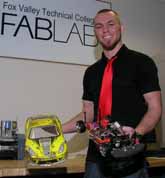Focus on Student Life
Spring 2010
Cast in a Leading Role
A student leader broadens her skills and perspective through campus activities.
Electrical Engineering Technology major Kamilah Coffin likes making things happen. That’s one reason why she enjoys her involvement in a variety of FVTC student organizations. She is secretary of the Student Government Association, secretary of the Electronics Club, and treasurer of the FAB LAB (Fabrication Laboratory) Club. “Student activities take you beyond your experiences in the classroom,” she says. “You meet other people and discover what’s happening on campus.”
Kamilah’s club experiences have strengthened her leadership skills. She helped generate excitement with club members by distributing a survey and then using the results to create activities. One new program involves Electronics and FAB LAB club members working together to create two machines that demonstrate electronics-related functions for competitions and events.
The experiences taught Coffin valuable lessons. “When working in a diverse group, you must balance personalities, attitudes, and backgrounds,” she says. “As a club officer, I’ve experienced turning ideas into programs, as well as working as a team to resolve conflicts, solve problems, and achieve goals.”
Vicky Barke, FVTC's director of Student Life, says students can get involved in more than 45 student organizations, ranging from the student newspaper to program-related clubs to intramural sports. “Becoming involved on campus and developing leadership skills are important parts of your college experience,” Barke says. “Participation allows you to build your network with potential employers, fellow students and staff, and helps you develop a co-curricular transcript to include in a job search.”
Student of Invention
A Mechanical Design student’s project puts him on the inside track to innovation.
Shannon Carlson is fascinated by how cars and planes work. This lifelong interest in automobiles and airplanes led him to enroll in Fox Valley Technical College’s Mechanical Design program in 2008. So when the final project for a product design and rapid prototyping class required the full assembly of an invention, he quickly decided to create a remote control race car.
 |
| Shannon Carlson |
His first step was to review remote control race car designs on the Internet and pinpoint the best approaches for his project. After designing parts on two different three-dimensional product design software applications, Carlson merged his two designs into a single concept. “My development process simulated real-life work situations that involve creating designs with different software packages or incorporating vendor-supplied parts into your prototype,” he explains.
With design in-hand, Carlson began building a prototype in the FAB LAB, which provides industrial-fabrication and electronics tools to enable students, instructors, and inventors to rapidly create product prototypes. He used the lab’s desktop 3D printer to build his car’s steering mechanism and drive-line components out of layers of plastic. Using the laser engraving cutter, he cut out the chassis and other flat car parts in plexiglass. He also purchased an off-the-shelf electronic remote control system and began assembly.
“FAB LAB technology enabled me to quickly produce the parts I needed,” says Carlson. “However, while production was easy, my original design did not quite fit together because of the different tolerances each machine holds. So I fine-tuned my designs and built a second set of parts to solve the problem. I quickly learned the importance of working out design flaws before producing the final prototype.”
Dean Sommerfeld, team leader for FVTC’s Mechanical Design program, says these sorts of projects help students develop critical skills. “Through varied projects, students learn about the overall development process, from creating a design to producing a final product,” he notes. “Project work prepares them for future jobs and teaches them the importance of creativity and new ideas.”
What’s next for Carlson? He plans to build a second car that is three times the size of his first one, powered by a two-cycle engine. Carlson lends advice to students who may aspire to be inventors. “The design field is so broad; you can take it wherever your interest lies,” he notes. “Seeing a project reach fruition, like someone using a kitchen blender that you designed, brings satisfaction to the work we do as mechanical designers.”